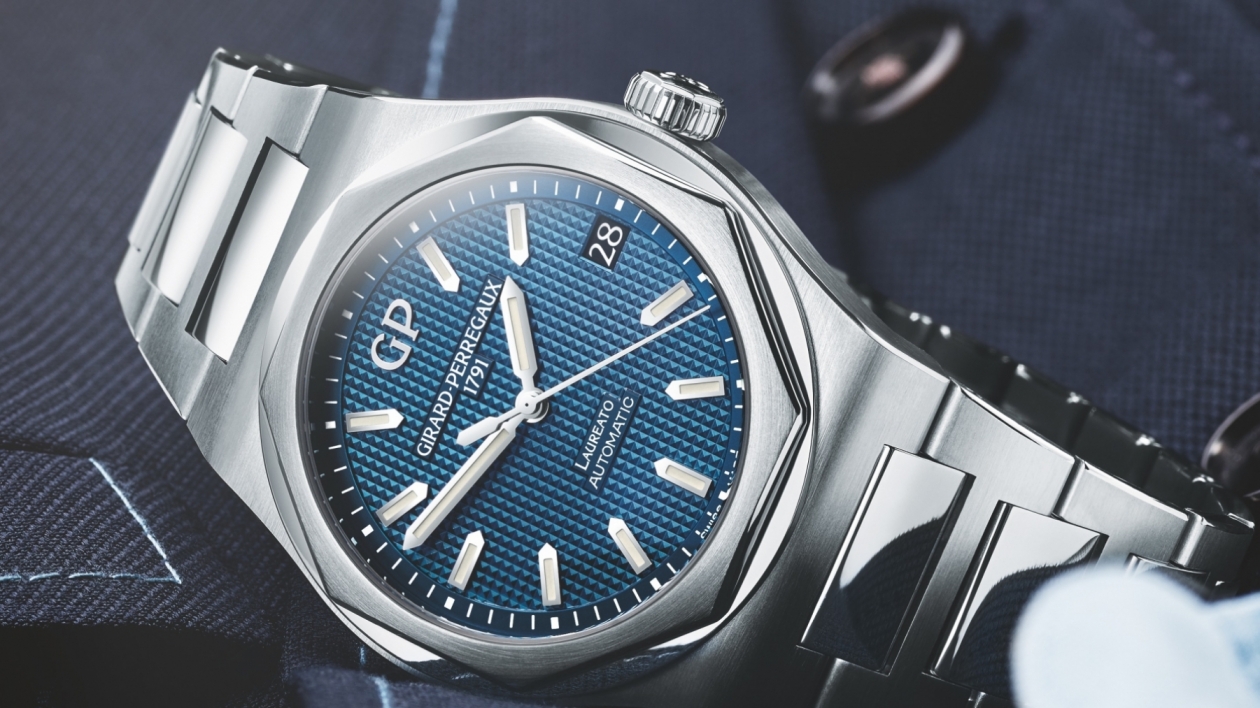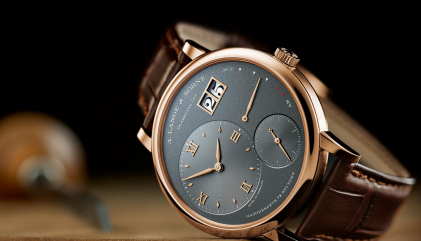Watch collectors had been awaiting its return. After a lengthy hiatus, which saw almost 30 different references, Girard-Perregaux finally brought the Laureato back into its collection in 2017. It had already made its comeback one year earlier with various limited editions commemorating Girard-Perregaux’s 225th anniversary. One of the latest models to join the family is this blue-dialled take on the fourth-generation Laureato, which we recently had the opportunity to spend some wrist time with.
A look back leads to the 1970s, a decade when the watch industry was responding to a demand for sporty and elegant timepieces that had a distinctive aesthetic and could be worn for every occasion. Girard-Perregaux commissioned a Milanese architect to design the Laureato, which
translates as the “graduate.” He placed an octagonal component atop a ring, thus joining a polygon and a circle. To create specific reflections of light, the sides of the octagon traced gently flowing lines rather than sharply defined edges, combined with convex and concave surfaces. The fluid transition from the case to the integrated metal bracelet followed both the taste of the time and the transformation in watch technology that Girard- Perregaux celebrated inside the Laureato in 1975: the first appearance of an uncommonly slim and compact quartz movement. This caliber defined the international standard with a frequency of 32,768 Hz. So it’s no surprise that quartz watches belong to the current Laureato collection.
Nor is it surprising to hear some sharp-tongued rogues mutter that the Laureato’s latest incarnation looks even more like Audemars Piguet’s Royal Oak, which Gérald Genta designed in 1972. With a brawny bezel and visible screws, Genta’s brainchild borrows some details from an old-fashioned diving helmet. With this timekeeping creation, the famed Swiss designer with Italian roots transformed the watch world at a time when
the Milanese architect likewise followed the zeitgeist and sketched his own designs for Girard-Perregaux, which are more reminiscent of the dome atop a Florentine cathedral.
The Laureato underwent its first revision in 1984. It encased a mechanical movement for the first time in 1995, when manufacture Caliber 3000 began ticking inside its case. The Laureato EVO2 was larger, its bezel broader and the links of its integrated stainless-steel bracelet shaped like the letter “H,” as are their counterparts on our contemporary test model. The case, which was formerly only available in stainless steel, now also comes in a titanium and gold version. The traditional stainless-steel bracelet is still available, but rubber straps and leather wristbands have been introduced as alternatives. In 1998, the legendary “Tourbillon Under Three Bridges” appeared in a Laureato model, proving that Girard-Perregaux’s unconventional mechanism is sturdy enough for use in a high-complication watch.
The third-generation Laureato, the EVO3, was available as a chronograph and with complications. Its lines have become gentler when compared to their counterparts on the EVO2. The interplay between satin-finished and polished elements can be seen in both the stainless-steel bracelet and the butterfly clasp with push-button closure. For the first time, the octagonal bezel is satin finished on top, while its sides and its underlying ring have a high-gloss finish. The case’s compact middle piece is brushed matte all the way to the points where it transitions into the wristband.
Glossy finishing shines on the screwed back, which has a window of sapphire crystal.
All these characteristics, including the case’s pressure resistance to 10 bar (100 meters), likewise distinguish our test watch, the fourth-generation Laureato. It updates its ancestors’ genetic code with a somewhat narrower bezel and a case with a slightly more angular middle piece and finely polished steps, thus assuring that this Laureato preserves its identity.
Despite the undeniably large diameter (42 mm) of its stainless-steel body, the Laureato Automatic is a mere 11 mm tall. This thinness assures that this sporty timepiece can be worn under the close-fitting cuff of a dress shirt when it accompanies its wearer on an evening at the theater. And that’s not all: The gentle lines of the case and the softly flowing feel of the linked bracelet make the Laureato a sporty and elegant companion to wear on many diverse occasions. The model is available with three different dial colors: silver, slate gray and blue, whereby the last-mentioned color, which characterises the dial on our test watch, marks an unexpectedly long-lasting trend.
The dial is decorated with a waffle-like clous de Paris pattern composed of numerous tiny pyramids, all neatly arranged in regular rank and file order. At first glance, this admittedly leads one to suspect that the Laureato has come a bit closer to the Royal Oak. But appearances are deceiving: this clous de Paris pattern is significantly different from the petite tapisserie embellishment on Audemars Piguet’s dials. Raised, luminous, hour appliqués and large, baton-shaped, glow-in-the-dark hands enhance the Laureato’s charm as a sports watch and simultaneously guarantee good legibility under all lighting conditions. The only blemish: the easy-to-read date display at 3 o’clock is black, a hue that doesn’t entirely harmonise with the blue dial. The date can be quickly reset by pulling out the well-screwed-down crown, which is easy to grasp, to its middle position and giving it a little twist. The crown’s styling emphasises the Laureato’s character as a sports watch. But beware: even if you have observed the six-hour curfew before and after you rapidly reset the date, the date display sometimes jumps to show a wrong number when you pull the crown into its hand-setting position. Moreover, a bit of unwanted play is also noticeable in the seconds hand when the crown is in this extracted position for precise adjustment of the hands. Fortunately, this little wiggle doesn’t interfere with to-the-second time setting because the seconds hand races back to its zero position as soon as the crown is released, but the phenomenon is nonetheless unusual.
The time display is powered by automatic manufacture Caliber GP01800-0008, which has only been on the market since 2017 and is celebrating its debut inside the 42-mm models of the Laureato collection. The intention here is obvious: Caliber GP01800-0008 is 30 mm in diameter, more than 6 mm larger than the basic movement in the GP3000 series, so it fits well inside these new and larger watch models. The GP3000 was installed inside 36-mm cases when it premiered in the 1990s. And for a short time, it seemed like it almost lost itself in the Sea Hawk’s spacious 44-mm case.
It is indeed a lovely sight to peer through the window of sapphire crystal, which six screws securely hold on the back of the 42-mm Laureato, and see how completely Caliber GP01800-0008 fills the interior of the case. The movement’s styling is essentially in accord with Girard-Perregaux’s characteristic attributes, but its design differs in a few noteworthy details. Although the rotor is ball borne, it adheres to the brand’s philosophy and winds the mainspring in only one direction of rotation (counterclockwise). The large barrel looks very handsome under a bridge of its own. A Triovis system is no longer used to finely adjust the balance: it has been replaced by an index system with an eccentric screw. This caliber was designed, fabricated and assembled in its traditional and meticulously crafted versions entirely on the brand’s premises.
As such, it delivers well-balanced and reliable performance inside the Laureato. When fully wound, it gained 3.6 seconds per day on our timing machine and 4.7 seconds per day on the wrist. All in all, these are commendable statistics for a luxury timepiece, assuming that one important number is generously overlooked: namely, the high price that Girard-Perregaux asks for this three-handed watch.
| Girard-Perregaux Laureato Automatic 42mm | |
|---|---|
| Manufacturer |
Girard-Perregaux SA, Place Girardet 1, 2301 La Chaux-de-Fonds, Switzerland |
| Reference Number |
81010-431-11A |
| Functions |
Hours, minutes, central second, date |
| Movement |
GP01800-0008, automatic, 28,800 vph, 28 jewels, Glucydur balance, Nivarox hairspring, eccentric screw for fine adjustment, Incabloc shock absorption, 54-hour power reserve, diameter = 30mm, height = 3.97mm |
| Case |
Stainless steel, anti-reflective sapphire crystal above dial, sapphire crystal at the back, water resistant to 100m |
| Bracelet and clasp |
Stainless steel, stainless steel butterfly clasp with lateral push-pieces |
| Rate results |
Deviation in seconds per 24 hours, fully wound/after 24 hours |
| Dial up |
+4.9 / +4.1 |
| Dial down |
+2.4 / +2.3 |
| Crown up |
+1.0 / +2.6 |
| Crown down |
+5.0 / +6.4 |
| Crown left |
+4.7 / +7.2 |
| Greatest deviation |
4.0 / 4.9 |
| Average deviation |
+3.6 / +4.5 |
| Average amplitude | |
| Flat positions | 307 degree / 286 degree |
| Hanging positions | 278 degree / 256 degree |
| Dimensions | Diameter = 42.5mm, height = 11.01 mm, weight = 146 g |
| Variations | Silver or slate-grey dial; steel case and alligator strap (Rs, 7.42 lakh); with titanium and rose-gold case and alligator strap (Rs. 10.98 lakh); with titanium adn rose-gold case and bracelet (Rs. 16.27 lakh) |
| Price | Rs. 7.96 lakh |






















